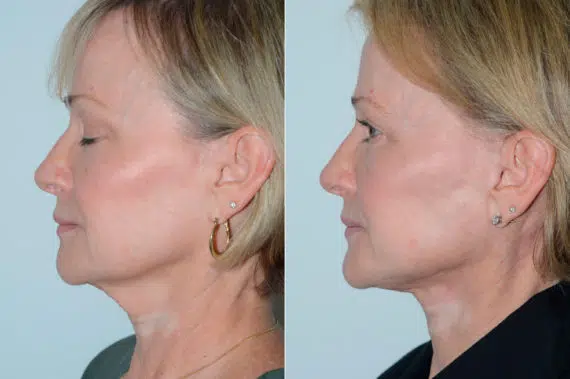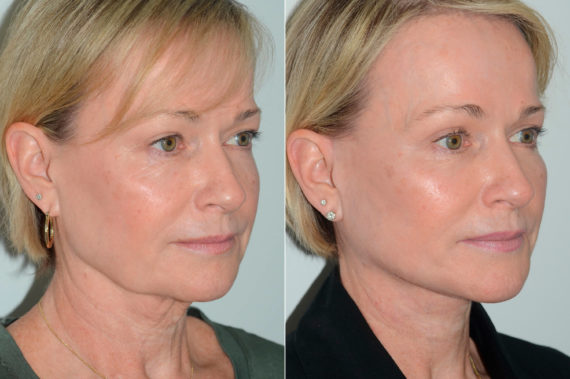Looking to add some youth to your complexion? A facelift might be your answer. This cosmetic surgery works by tightening the facial muscles, moving around some tissues, and shedding any excess skin. Sounds simple, right? However, it is important to take care of your incision lines during the post-operative period.
This article will provide instructions on how to properly care for and heal your incision after this procedure. With the right attention, you can ensure that healing takes place in the best possible way.

Understanding the Facelift Surgery
Facelift surgery, one of many cosmetic surgeries available today, is designed to give a youthful look by reducing the visible signs of aging in facial tissues and muscles. Primarily, the focus of this surgery, often combined with a neck lift, lies in the treatment of sagging facial tissues that have lost their firmness over time. Additionally, to smoothen the facial skin and bring forth a youthful appearance, scraping away any excess skin is done.
The Facelift Procedure
The process starts with the patient’s comfort being served via anesthetic. After that, the board-certified plastic surgeon then proceeds to make placement of incisions in the hairline at the temples, then continues down around the ear to finish at the lower scalp.
The underlying tissue is rearranged and tightened while extra skin is eliminated. Usually lasting two to four hours, this procedure leaves has a facelift recovery time frame of a few weeks.
Questions about your procedure?
Schedule a consultation with Dr. Andres Bustillo.
Facelift Surgeries Types
Facelift surgeries are sought after for a youthful appearance. The primary type of surgery is a rhytidectomy which is a common procedure. It reduces the wrinkles and sagging caused by aging. The surgery involves removing or altering the facial skin to create a smoother look. But remember, it might cause severe pain.
Mini Facelift
Alternatively, consider the mini facelift. It is another type of surgery that focuses on the lower part of the face. The mini facelift targets minimal incision lines and is less extensive than the traditional facelift. But don’t overlook the fact that both surgeries require recovery time and careful aftercare.
Deep place Facelift
This surgery is a type of cosmetic procedure that offers more dramatic results than the traditional rhytidectomy or mini facelift. This procedure is more invasive and requires a longer recovery period, but it can achieve remarkable results by lifting deep tissues with minimal scarring. Deep plane facelifts also require highly precise incisions that may be more visible initially but will fade over time with proper care.
Understanding the Risks
One common complication that may emerge after the surgical procedure is a hematoma. Hematomas are typically characterized by a mass of clotted blood that forms within a tissue, organ, or space within the body. The occurrence of a hematoma is dependent on many factors, but it is typically due to bruising in the operation area.
Another possible issue can be a facial nerve injury. This entails damage to the set of seven cranial nerves that control facial movement and transmit sensory data to the brain. These nerves are crucial in feeling and movement, hence any injury can be significant.
Repeated bruising, for instance, can damage nerves and lead to complications like loss of sensation or muscle weakness. Besides these, other complications may encompass chronic pain, infection, or scarring. Report the following signs:
- Temperature elevation
- Sudden or excessive swelling
- Discharge for the wound
- Bleeding
How to Care for Your Facelift Incision Lines
Yes, you’ve taken a significant step to improving your look – a facelift procedure. So now, your journey to a new you begins with the appropriate care for your incision lines. This wound care action is highly important for quicker healing and reducing chances of infection. This quick guide provides you with wound care instructions that’ll help you on your journey through those first days after surgery.
Keep your face clean
Starting with the first step, you’ll need to take care of your facial skin by keeping it clean. Use a gentle washcloth to carefully clean the incision sites at least twice daily. Avoid rubbing and only pat dry post-washing. Hydrogen peroxide should be utilized with extreme care. Only a small amount should be used to clean the suture lines, and not directly, as it may harm the surrounding skin.
Protecting the incision
Cover the incisions with a surgical dressing to protect them from contamination and promote skin regeneration. Dressings should be replaced according to instructions, typically once or twice per day. For any evidence of infection, go to your surgeon. Also, limit sun exposure for a few months after the surgery.
Avoid makeup and hair coloring
Wait for your doctor’s approval before using cosmetics or hair dye on your incision lines. Makeup with harsh chemicals can irritate the incision sites and lead to infection. Hair coloring treatments should also be avoided as they may contain damaging ingredients that can harm your skin. It’s best to wait 2-4 weeks before using any makeup or hair coloring products.
Moisturizing
Next on the list of wound care is moisturizing. Antibiotic ointments could be useful here. It should be applied sparingly to avoid over-moisturizing. Also, if you notice the skin incision line becoming red, hot, or swollen, prompt medical attention is required.
Once the doctor allows it, you can start applying a scar cream recommended by the surgeon to help reduce the visibility of incision lines.

Using ice packs
Afterward, holding ice packs on the swollen areas can improve comfort. However, these packs should be kept away from the actual facial incision to prevent slowing of the healing process. And remember, wearing a compression garment as instructed can reduce swelling and aid the healing process.
Pain Medications
Doctors typically prescribe medications to help the pain control and speed up the healing process during post-operative care. These medications are chemically formulated to target specific concerns, such as managing blood circulation and protecting nerves during the healing process. They also aid in reducing inflammation and preventing infections.
Blood thinners should be avoided during post-operative care as they may increase the risk of complications and interfere with the healing process.
Activities after Facelift
Following surgery, it is also essential to understand how your levels of physical activity may need adjusting. Typically, this involves a gradual return to routine actions, avoiding strenuous activity initially to not damaging the sites, and increasing blood pressure. It’s highly normal for your activity levels to diminish in the days or weeks post-surgery. Keep in mind, though, that this is just a phase in your recovery process.
As you get better, normal activities will increase, and you can gradually start integrating more strenuous exercises back into your routine. Paying attention to your body and not pushing it too hard is key in this stage. Be patient with your body and allow it ample time to heal.
Facelift Recovery Timeline
The first hours after surgery tend to be the most challenging, often marked by swelling, bruising, and amounts of discoloration. It is advised to stay in a reclining position of a 30-45 degree angle to minimize the swelling. After the first 72 hours of your procedure, you can take a shower or bath, but not with very warm water. Comfort and maintenance of hygiene are key during these days after surgery.
As you transition into the first week after surgery, the majority of the swollen tissues will start to subside, and you can wear contact lenses again. The skin may feel tight and numb around the ear lobe, face, and neck, but these symptoms will slowly improve over time. Ensuring a proper and balanced diet, as well as drinking plenty of water, are important throughout this recovery phase. This is where the complexities of these surgeries come into play.
Weeks after surgery, significant improvements will begin to show. However, keep your follow-up appointments to monitor progress and detect any complications early. Progression into the months after surgery reveals significant changes as your new facial contour settles in. Keep healthy lifestyle habits to maintain and enhance the results. Contingent on the individual, the final results may take anywhere from a few months to a year following the surgery to fully manifest.
Why Following the Aftercare Instructions
Your Facelift qualified surgeon should be seen as your partner in health, guiding and instructing you throughout your recovery. The aftercare instructions they provide are grounded in their wealth of experience and essential to your successful healing. Therefore, swiftly adhering to them not only fosters your relationship with your surgeon but also promotes your healing process. After all, a satisfied client is the pinnacle of an experienced facelift surgeon’s success.
Talk with a facelift expert
To achieve a fresh appearance, seek guidance from Dr. Andres Bustillo. He has years of experience, expertise, and a proven track record in plastic surgery. Trust his meticulous skill for successful outcomes. If you’re considering facelift surgery in Coral Gables or other facial procedures, schedule a consultation with him today. Trust Dr. Bustillo to bring your aesthetic dreams to life!




